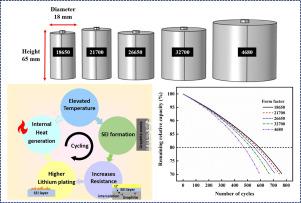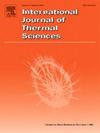Elucidating effects of form factors on thermal and aging behavior of cylindrical lithium-ion batteries
IF 4.9
2区 工程技术
Q1 ENGINEERING, MECHANICAL
International Journal of Thermal Sciences
Pub Date : 2024-11-30
DOI:10.1016/j.ijthermalsci.2024.109564
引用次数: 0
Abstract
Cylindrical lithium-ion cells are commercially available in different form factors, e.g., 18650, 21700, 26650, 32700 and 4680. The larger 4680 cells are gaining popularity, especially after the patent filing by Tesla. This paper aims to perform a comparative analysis of the thermal and aging behavior of different form factors using NMC–graphite chemistry during prolonged cycling at moderate operating conditions. A physics-based aging model for lithium-ion batteries is introduced, incorporating side reactions such as solid electrolyte interface (SEI) formation, SEI reformation due to graphite layer cracking, and lithium plating. During cycling, the cell temperature increases with time for all form factors due to internal heat generation. Notably, larger form factor cells experience higher temperatures, attributed to their inferior surface-to-volume ratio for heat dissipation, thereby accelerating both SEI formation and triggering lithium plating in subsequent cycles. This accelerated aging manifests in increased heat generation and prolonged charging for larger cells. The 4680 cell showed the highest rate of capacity loss with a 20% reduction over 480 cycles as compared to the 600 cycles of the 18650 cell. Highlighting accelerated aging in the larger cells due to suboptimal heat dissipation, this study underscores the pressing need for advanced thermal management strategies tailored to the unique challenges posed by larger cells.

形状因素对圆柱形锂离子电池热老化性能的影响
圆柱形锂离子电池在商业上有不同的形状因素,例如18650,21700,26650,32700和4680。更大的4680电池越来越受欢迎,尤其是在特斯拉申请专利之后。本文旨在使用nmc -石墨化学对不同形状因素在中等操作条件下长时间循环的热老化行为进行比较分析。介绍了一种基于物理的锂离子电池老化模型,该模型考虑了固体电解质界面(SEI)的形成、石墨层开裂导致的SEI重整以及锂镀层等副反应。在循环过程中,由于内部产生热量,电池温度随着时间的推移而升高。值得注意的是,尺寸较大的电池由于其散热的表面体积比较差,因此温度更高,从而加速SEI形成,并在随后的循环中触发锂电镀。这种加速老化表现为更大的电池产生的热量增加和充电时间延长。4680电池显示出最高的容量损失率,与18650电池的600次循环相比,4680电池在480次循环中减少了20%。该研究强调了由于散热不佳而导致的大型电池加速老化,强调了针对大型电池带来的独特挑战量身定制先进热管理策略的迫切需要。
本文章由计算机程序翻译,如有差异,请以英文原文为准。
求助全文
约1分钟内获得全文
求助全文
来源期刊

International Journal of Thermal Sciences
工程技术-工程:机械
CiteScore
8.10
自引率
11.10%
发文量
531
审稿时长
55 days
期刊介绍:
The International Journal of Thermal Sciences is a journal devoted to the publication of fundamental studies on the physics of transfer processes in general, with an emphasis on thermal aspects and also applied research on various processes, energy systems and the environment. Articles are published in English and French, and are subject to peer review.
The fundamental subjects considered within the scope of the journal are:
* Heat and relevant mass transfer at all scales (nano, micro and macro) and in all types of material (heterogeneous, composites, biological,...) and fluid flow
* Forced, natural or mixed convection in reactive or non-reactive media
* Single or multi–phase fluid flow with or without phase change
* Near–and far–field radiative heat transfer
* Combined modes of heat transfer in complex systems (for example, plasmas, biological, geological,...)
* Multiscale modelling
The applied research topics include:
* Heat exchangers, heat pipes, cooling processes
* Transport phenomena taking place in industrial processes (chemical, food and agricultural, metallurgical, space and aeronautical, automobile industries)
* Nano–and micro–technology for energy, space, biosystems and devices
* Heat transport analysis in advanced systems
* Impact of energy–related processes on environment, and emerging energy systems
The study of thermophysical properties of materials and fluids, thermal measurement techniques, inverse methods, and the developments of experimental methods are within the scope of the International Journal of Thermal Sciences which also covers the modelling, and numerical methods applied to thermal transfer.
 求助内容:
求助内容: 应助结果提醒方式:
应助结果提醒方式:


